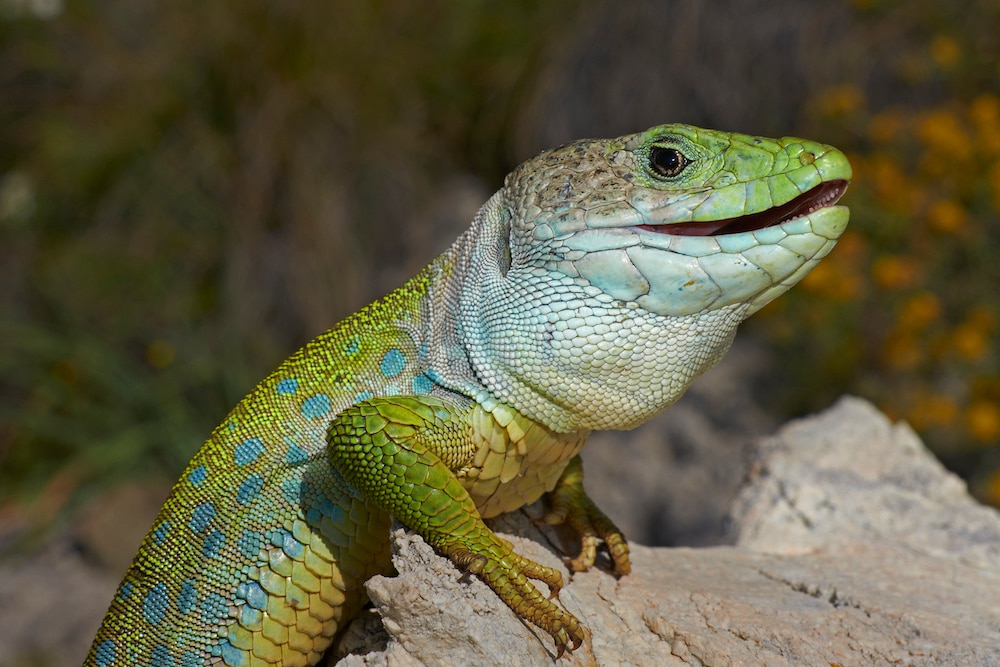Create a free profile to get unlimited access to exclusive videos, sweepstakes, and more!
Lizards are like evolutionary mood rings, and now we can predict the color change
Reptiles can't tell your future, but they can tell you what color their scales will be.

What if you picked up a lizard and realized there was something more under its skin?
The scales of the ocellated lizard form labyrinthine patterns of black and green. This species probably evolved its coloration and type of pattern (as opposed to spots, stripes, or anything else) so it could dodge predators and creep up on prey, among other things. What almost seems like magic is that you can predict how its green or black scales will end up appearing once it transitions from its juvenile phase to adulthood, no crystal balls or mood rings necessary.
Each lizard has a slightly different labyrinthine pattern. It has now been found, regardless of which individual scales turn from black to green or green to black, that the pattern can always be reduced to the same simple mathematical model. University of Geneva researchers Szabolcs Zakany, Stanislav Smirnov, and Michel Milinkovitch were fascinated by the order they found in what looked like chaos. They recently published a study in Physical Review Letters.
“We had this cellular automaton which was realized on the back of the lizard, and it produced patterns,” they told SYFY WIRE. “So the question was whether we could take the Lenz-Ising model and apply its few parameters to get the typical patterns that we see on the lizard.”
What is known as a cellular automaton is the way that units — like scales — on a certain grid evolve according to rules put in place by the units right next to them. This grid had to be converted from square to hexagonal form to fit lizard’s scales. This allowed Zakany, Smirnov, and Milinkovitch to apply the Lenz-Ising model, usually used to predict the configurations of magnetic particles, which is why it was so unexpected. Particles can only be in a state of +1 or -1 and interact with those directly next to them. It translates to the lizard very easily. Meaning, scales can either be black or green and can only interact with those next to them.
Under the Lenz-Ising model, scale color change in an ocellated lizard will always change from green to black, or vice versa depending on the interactions with scales right next to them, and those changes are predictably going to result in a labyrinthine pattern. If a green scale is surrounded by too many green scales, things get uncomfortable and that green scale is likely to morph into a black scale. The same goes for a black scale surrounded by too many black scales; it tends to shift to green. This is a simple model that lies beneath many different things, from molecules to cells to animals, some so complex you wonder how they can be ordered at all. Math can be magic.
“What is important is you have entities that interact at a given scale, and you these interactions generate phenomena at much larger scales,” the researchers said. “So you can generate complexity simply, and that’s very contrary to intuition.”
For lizards and many other creatures trying to survive, they are both able to catch prey without being seen and avoid becoming prey because of their camouflage. The secret to this is not allowing anything to make out your silhouette. This is why particular arrangements of scales or feathers break that outline and confuse both what wants to eat the lizard and what it wants to eat. Juvenile and adult ocellated lizards live in different habitats, which may also be why their scale pigmentation changes as they grow. They need to blend in with what surrounds them.
So could you rewind this model to go far back in time and find out under what conditions certain configurations of scales originated? Though the researchers think this is in the realm of possibility, it is not exactly efficient because it would end up being a long and tedious process. This kind of reverse engineering works best on something that evolves slowly. Lizard scale configurations tend to evolve pretty fast, so there are not enough existing species of ocellated lizards to efficiently make this inference.
“Evolution produces different patterns,” the researchers said. “Those that win in the end are the easiest and most efficient. In some sense, we are reducing the complexity of all these models to something so extremely simple, and what is interesting is that it is actually realized in this lizard.”

























